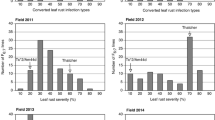Summary
Part II of this series gives a classification, based on blackarm resistance, of over 160 varieties and strains of cotton. Complete immunity was not found in any New World types but exists in some of the Old World species. Several of the results disagreed with statements by St Vincent workers, some of the strains classed as “somewhat resistant”, “highly resistant” and “immune” by them being found at Shambat to be fully susceptible. It is suggested that St Vincent results were based on differences in primary infection (seed infection), rather than on true tissue resistance and that these differences were accentuated by the presence or absence of seed fuzz and by plant vigour.
Part III shows the type of blackarm resistance inheritance obtaining in the crosses Uganda B. 31 × 514 and B. 31 × 513 (all three are American Upland types) the latter results being further clarified by crosses between 513 and Sakel.
Uganda B. 31 contains resistance factorsB 1 andB 2 plus modifiers and shows grade “3” resistance; 514 contains no major resistance factors but numerous minor ones and is graded as “10” (grade “0” represents immunity and “12” full susceptibility). The first backcross to 514 gives a bimodal curve with peaks at grades “4” and “9” and displaying an approximate 1 : 1 ratio instead of the 3 : 1 ratio expected. InF 2 and in theF 2 of this first backcross, bimodal curves are again obtained, but these bear some resemblance to the 12 : 3 : 1 ratio expected. The reasons for these anomalies are discussed.
It is shown that 513, a selection from a Punjab American Upland importation with grade “5”–“6” resistance, contains factorB 2 together with several very weak resistance factors.
Similar content being viewed by others
References
Bailey, M. A. (1927).Rep. Exp. Stas Emp. Cott. Gr. Corp. (Anglo-Egyptian Sudan), 1925–6, p. 119.
-- (1928).Rep. Exp. Stas Emp. Cott. Gr. Corp. (Anglo-Egyptian Sudan), 1926–7, p. 154.
-- (1929).Rep. Exp. Stas Emp. Cott. Gr. Corp. (Anglo-Egyptian Sudan), 1927–8, pp. 159–60.
Burd, L. H. (1925).Rep. Exp. Stas Emp. Cott. Gr. Corp. 1923, 1924 and (South Africa only) 1925, p. 41.
Evelyn, S. H. (1936).Progr. Rep. Exp. Stas Emp. Cott. Gr. Corp. 1934–5, p. 141.
-- (1937).Progr. Rep. Exp. Stas Emp. Cott. Gr. Corp. 1935–6, p. 136.
Evelyn, S. H. &Harland, S. C. (1934).Rep. Exp. Stas Emp. Cott. Gr. Corp. 1932–3, pp. 210 and 230.
Hansford, C. G. (1934). “Blackarm disease in Uganda.”Rep. Emp. Cott. Gr. Corp. Conf. July 1934, pp. 178–88.
Harland, S. C. (1939).The Genetics of Cotton, p. 145.
Harland, S. C. &Evelyn, S. H. (1933).Rep. Exp. Stas Emp. Cott. Gr. Corp. 1931–2, p. 162.
Knight, R. L. (1935). “The effect of shade on American cotton.”Emp. J. exp. Agric. 3, 37.
Knight, R. L. &Clouston, T. W. (1939). “The genetics of blackarm resistance. I. FactorsB 1 andB 2.”J. Genet. 38, 133–59.
Lambert, A. R. (1938). “New Sakel strains in the Anglo-Egyptian Sudan.”Emp. Cott. Gr. Rev. 15, 15.
Squire, F. A. (1938). “Survival of pink bollworm in the field.”Rep. Emp. Cott. Gr. Corp. Conf. September 1938.
Author information
Authors and Affiliations
Additional information
This research was carried out as part of the programme of work of the Plant Breeding Section of the Agricultural Research Institute, Sudan Government.
Rights and permissions
About this article
Cite this article
Knight, R.L., Clouston, T.W. The genetics of blackarm resistance. Journ. of Genetics 41, 391–409 (1941). https://doi.org/10.1007/BF02983029
Issue Date:
DOI: https://doi.org/10.1007/BF02983029




